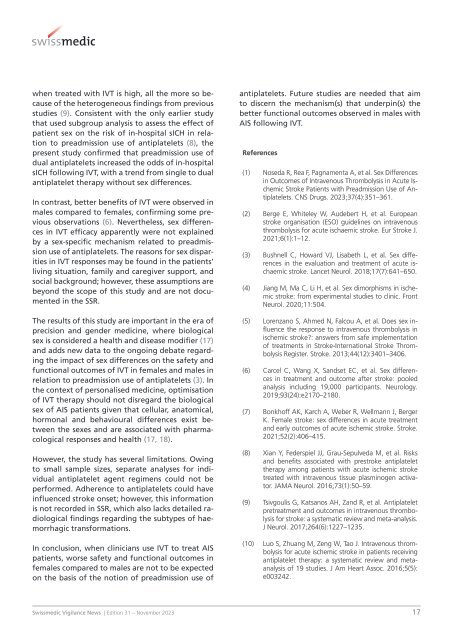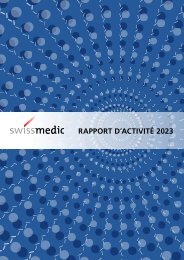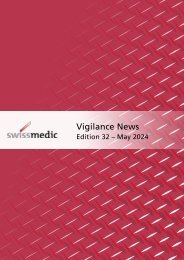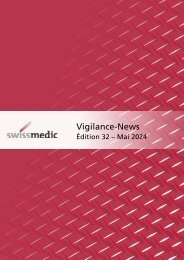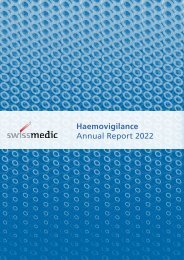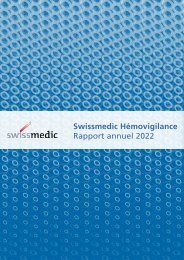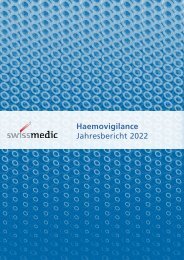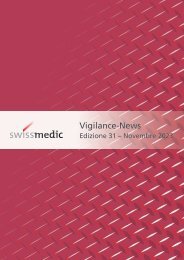Swissmedic Vigilance News
Edition 31 – November 2023
Edition 31 – November 2023
You also want an ePaper? Increase the reach of your titles
YUMPU automatically turns print PDFs into web optimized ePapers that Google loves.
when treated with IVT is high, all the more so because<br />
of the heterogeneous findings from previous<br />
studies (9). Consistent with the only earlier study<br />
that used subgroup analysis to assess the effect of<br />
patient sex on the risk of in-hospital sICH in relation<br />
to preadmission use of antiplatelets (8), the<br />
present study confirmed that preadmission use of<br />
dual antiplatelets increased the odds of in-hospital<br />
sICH following IVT, with a trend from single to dual<br />
antiplatelet therapy without sex differences.<br />
In contrast, better benefits of IVT were observed in<br />
males compared to females, confirming some previous<br />
observations (6). Nevertheless, sex differences<br />
in IVT efficacy apparently were not explained<br />
by a sex-specific mechanism related to preadmission<br />
use of antiplatelets. The reasons for sex disparities<br />
in IVT responses may be found in the patients’<br />
living situation, family and caregiver support, and<br />
social background; however, these assumptions are<br />
beyond the scope of this study and are not documented<br />
in the SSR.<br />
The results of this study are important in the era of<br />
precision and gender medicine, where biological<br />
sex is considered a health and disease modifier (17)<br />
and adds new data to the ongoing debate regarding<br />
the impact of sex differences on the safety and<br />
functional outcomes of IVT in females and males in<br />
relation to preadmission use of antiplatelets (3). In<br />
the context of personalised medicine, optimisation<br />
of IVT therapy should not disregard the biological<br />
sex of AIS patients given that cellular, anatomical,<br />
hormonal and behavioural differences exist between<br />
the sexes and are associated with pharmacological<br />
responses and health (17, 18).<br />
However, the study has several limitations. Owing<br />
to small sample sizes, separate analyses for individual<br />
antiplatelet agent regimens could not be<br />
performed. Adherence to antiplatelets could have<br />
influenced stroke onset; however, this information<br />
is not recorded in SSR, which also lacks detailed radiological<br />
findings regarding the subtypes of haemorrhagic<br />
transformations.<br />
In conclusion, when clinicians use IVT to treat AIS<br />
patients, worse safety and functional outcomes in<br />
females compared to males are not to be expected<br />
on the basis of the notion of preadmission use of<br />
antiplatelets. Future studies are needed that aim<br />
to discern the mechanism(s) that underpin(s) the<br />
better functional outcomes observed in males with<br />
AIS following IVT.<br />
References<br />
(1) Noseda R, Rea F, Pagnamenta A, et al. Sex Differences<br />
in Outcomes of Intravenous Thrombolysis in Acute Ischemic<br />
Stroke Patients with Preadmission Use of Antiplatelets.<br />
CNS Drugs. 2023;37(4):351–361.<br />
(2) Berge E, Whiteley W, Audebert H, et al. European<br />
stroke organisation (ESO) guidelines on intravenous<br />
thrombolysis for acute ischaemic stroke. Eur Stroke J.<br />
2021;6(1):1–12.<br />
(3) Bushnell C, Howard VJ, Lisabeth L, et al. Sex differences<br />
in the evaluation and treatment of acute ischaemic<br />
stroke. Lancet Neurol. 2018;17(7):641–650.<br />
(4) Jiang M, Ma C, Li H, et al. Sex dimorphisms in ischemic<br />
stroke: from experimental studies to clinic. Front<br />
Neurol. 2020;11:504.<br />
(5) Lorenzano S, Ahmed N, Falcou A, et al. Does sex influence<br />
the response to intravenous thrombolysis in<br />
ischemic stroke?: answers from safe implementation<br />
of treatments in Stroke-International Stroke Thrombolysis<br />
Register. Stroke. 2013;44(12):3401–3406.<br />
(6) Carcel C, Wang X, Sandset EC, et al. Sex differences<br />
in treatment and outcome after stroke: pooled<br />
analysis including 19,000 participants. Neurology.<br />
2019;93(24):e2170–2180.<br />
(7) Bonkhoff AK, Karch A, Weber R, Wellmann J, Berger<br />
K. Female stroke: sex differences in acute treatment<br />
and early outcomes of acute ischemic stroke. Stroke.<br />
2021;52(2):406–415.<br />
(8) Xian Y, Federspiel JJ, Grau-Sepulveda M, et al. Risks<br />
and benefits associated with prestroke antiplatelet<br />
therapy among patients with acute ischemic stroke<br />
treated with intravenous tissue plasminogen activator.<br />
JAMA Neurol. 2016;73(1):50–59.<br />
(9) Tsivgoulis G, Katsanos AH, Zand R, et al. Antiplatelet<br />
pretreatment and outcomes in intravenous thrombolysis<br />
for stroke: a systematic review and meta-analysis.<br />
J Neurol. 2017;264(6):1227–1235.<br />
(10) Luo S, Zhuang M, Zeng W, Tao J. Intravenous thrombolysis<br />
for acute ischemic stroke in patients receiving<br />
antiplatelet therapy: a systematic review and metaanalysis<br />
of 19 studies. J Am Heart Assoc. 2016;5(5):<br />
e003242.<br />
<strong>Swissmedic</strong> <strong>Vigilance</strong> <strong>News</strong> | Edition 31 – November 2023<br />
17


